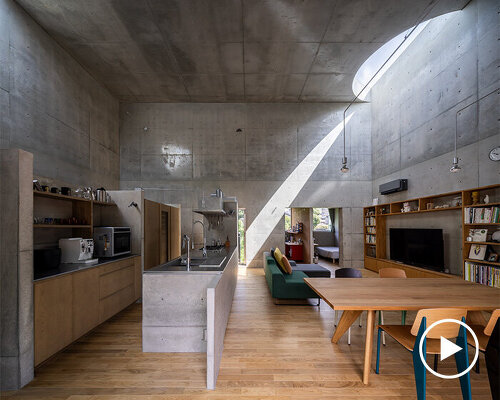takeshi hosaka builds two-story concrete residence in tokyo
In Bunkyo, Tokyo, architect Takeshi Hosaka designs Yayoi House for a family of four, rooting domestic life in an ecosystem of plants, water, and light. The reinforced concrete residence spans two stories and prioritizes cyclical living. From rooftop rainwater runoff to edible wall-climbing vines, the home integrates natural processes within the city, creating a resilient, self-sustaining habitat.
The decision to build only two stories instead of three was deliberate—an intentional move to create a vertical canvas where sunlight and moonlight could refract across raw concrete surfaces. Two large, semicircular skylights, set diagonally from one another, channel celestial light into the heart of the home. This luminous core opens up into a generous, nearly six-meter-high space that unites the living, dining, and kitchen areas. Surrounding this central volume are the terrace, the children’s rooms, the master bedroom, and the wife’s hobby room, where aquariums and fish tanks introduce a living element to the interior.
all images by Noboru Inoue
yayoi house integrates nature into everyday life
At first glance, Yayoi House stands out for its unique environmental approach. Tokyo-based architect Takeshi Hosaka wraps the structure with greenery. Bitter gourd vines scale the walls, biotopes cluster at the ground, and rainwater drips openly from roof to earth. Water flows along uncovered gutters, down the exterior walls, and into a curated biotope near the entrance. Initially maintained by the family, this aquatic microcosm is later left to self-regulate, evolving into a miniature ecosystem of plankton, plants, and fish. The system is both visible and experiential: glimpsed from a semicircular window inside the foyer and animated during daily rituals like entering the home or bathing beside a planted inner garden.
Hosaka also threads in a subtle food cycle. Waste from the kitchen garbage processor nourishes the terrace plants, yielding nutrient-rich soil. This closed-loop logic of waste, water, and growth exemplifies the architect’s intention, which is to embed the basic elements of nature within the city and in daily life.
Takeshi Hosaka designs Yayoi House for a family of four
the reinforced concrete residence spans two stories
the architect carves two large, semicircular skylights, set diagonally from one another
the skylights channel celestial light into the heart of the home
this luminous core opens up into a generous, nearly six-meter-high space
uniting the living, dining, and kitchen areas
a vertical canvas for sunlight and moonlight to refract
light reflects across raw concrete surfaces
the terrace, the children’s rooms, the master bedroom, and the wife’s hobby room surround the central volume
rooting domestic life in a deliberate ecosystem of plants, water, and light
Yayoi house prioritizes cyclical living
a resilient, self-sustaining habitat
project info:
name: Yayoi House
architect: Takeshi Hosaka Architects | @takeshi_hosaka_official
location: Bunkyo, Tokyo, Japan
site area: 202.86 square meters
building area: 120.92 m² square meters
total floor area: 218.55 m² square meters
lead architect: Takeshi Hosaka
structure: Kenji Nawa / NAWAKENJI-M
photographer: Noboru Inoue
film: Ryuto Fujii
The post semicircular skylights cast sunbeams across takeshi hosaka’s concrete residence in tokyo appeared first on designboom | architecture & design magazine.

